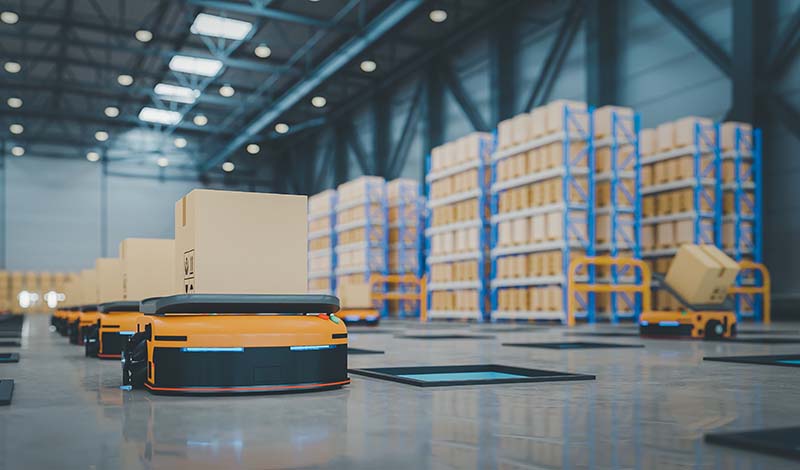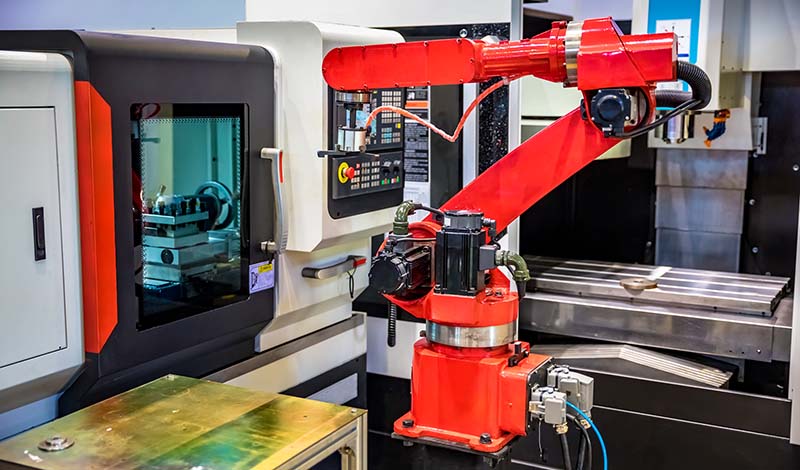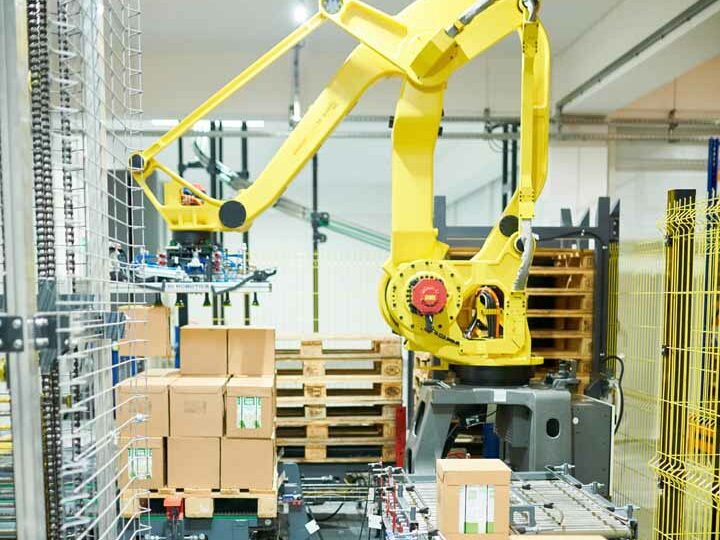
Autonomous industrial robots are being used more and more in many industries. They help increase productivity, improve safety, and reduce costs. These robots are key to warehouse automation because they can do tasks that are hard for people to do effectively and efficiently.
But there are different types of autonomous industrial robots, each suited to specific roles. So how do you choose the best option for your business? Read on to learn more.
In the autonomous robots industry, there are several types of industrial robots. We generally divide these robots based on their level of autonomy and artificial intelligence (AI).
1
Smart or intelligent robots do not rely solely on a programmed set of instructions. Instead, they are truly autonomous, gathering data in real time and making decisions based on this information. This makes them suitable for more complex tasks where understanding the environment is necessary.
Example: Autonomous Mobile Robots (AMRs)
Autonomous Mobile Robots (AMRs) use machine learning and artificial intelligence AI to understand their surroundings and learn as they work. They are often used for picking and packing orders in warehouses, improving order fulfillment by speeding up the process. AMRs are changing industrial spaces by increasing productivity and reducing costs.
2
Adaptive robots are partly programmed but also collect data about their surroundings and how they are working. This makes them smarter than programmable robots but not as advanced as fully autonomous devices like AMRs.
Example: Automatic Guided Vehicles (AGVs)
Automatic Guided Vehicles (AGVs) are programmed to follow specific routes as they move around industrial spaces. They need sensors to help them respond to changes around them, which supports safe operation. The most advanced AGVs can handle complex environments, opening doors and avoiding obstacles as they move around the site. These robots are commonly used in materials handling, moving items from point A to point B.
3
Programmable robots work autonomously but require human control to set up their tasks. These robots are highly suited to repetitive tasks, such as precise manufacturing operations.
Example: Robot Arms
A robot arm does not need to gather information from its surroundings. Instead, it simply follows its programmed instructions, repeating each task with precision and reliability. Robot arms are often found on the assembly line, performing tasks like welding or painting.
4
Some robots are designed to work side by side with humans—these are called collaborative robots. They assist workers in tasks that require both human creativity and machine precision, enhancing overall efficiency.
Example: Universal Robots UR Series
Cobots, equipped with sensors and programming to detect human presence and avoid collisions, are used in manufacturing for tasks like assembly and inspection. They handle repetitive tasks, enabling human workers to focus on more complex aspects of the job.

Investing in advanced automation should be worthwhile—it needs to be cost-effective and give real benefits to your business. With ongoing technological advancements, the adoption of autonomous robots is becoming more accessible for businesses of all sizes. Our clients agree that this investment is worthwhile. They tell us about many benefits of using industrial robots in their own operations.
1
Robots are great at doing repetitive tasks over and over without losing accuracy or speed. Your workers, on the other hand, may make mistakes, which can be costly. Even well-trained teams can have errors that increase costs.
Industrial robots greatly increase reliability. They can integrate directly with quality assurance processes, allowing you to guarantee the quality of your products. This level of consistency is hard to achieve with human workers alone.
2
These robots improve efficiency, allowing you to complete more tasks in less time. Robots don’t need breaks, so you can increase productivity significantly.
These solutions are designed not to replace human workers but to support them by handling tasks that are less suitable for people. Robots do these tasks faster and more reliably, helping businesses to promise more to their customers and partners in the supply chain, and deliver consistently.
3
When you use robots in your operations, you help make your facility as safe as possible. Automated systems with AI handle heavy lifting and repetitive inventory tasks, reducing risks to your workers.
All businesses must provide safe workplaces, and automated systems help make this happen. By reducing the need for human intervention in dangerous tasks, you can meet safety regulations more easily.
4
With autonomous industrial robots working in your environment, you can reduce your reliance on large human teams. While robots don’t replace human teams, you can grow your business by adding new abilities and capacity without hiring many new employees.
Increased efficiency will enable you to deliver projects and orders more quickly, boosting your revenue. Meanwhile, better quality control helps you reduce waste.
5
Robots equipped with advanced sensors and AI can gather vast amounts of data about their operations and surroundings, which can be invaluable for businesses. This data can be analyzed to optimize workflows, enhance product development, and inform strategic decisions, ultimately leading to better business outcomes.
6
With industrial robots, companies can quickly adapt to changing demands or new projects. Robots can be reprogrammed to accommodate new tasks, allowing businesses to pivot efficiently without significant downtime. This flexibility gives companies a competitive edge in rapidly shifting markets.
7
By increasing precision and efficiency, robots can help businesses minimize waste and reduce energy consumption. Automated systems optimize material usage, decrease emissions during production, and contribute to more sustainable operations, aligning with many companies’ environmental goals.
8
Contrary to popular belief, robots do not replace human workers. Instead, they allow them to focus on more valuable tasks that require creativity and critical thinking. By taking over repetitive or dangerous tasks, robots can improve the overall well-being of workers, reducing physical strain and injuries.

At Process Equipment & Controls (PEC), we help clients understand which robots are best for their needs. For example, you might need a smart industrial robot to fully automate a complex and changing place like a distribution center. But for repetitive manufacturing tasks, a programmable robot may be better and cost less to start with.
We use our experience to help you plan the best way forward for your business. Our robotic systems are designed to meet your specific needs. From there, we work with you and your teams to implement and manage the system. Our robot experts make sure you get the right autonomous system and get the most out of it.
We can help you with implementing autonomous robots that fit into your existing systems, ensuring a smooth transition. Our goal is to enhance productivity and drive efficiency in your operations.
Are you ready to harness the benefits of robot solutions and systems in your business? Do you want to learn more about how artificial intelligence can transform your industrial facility?
At PEC, we serve businesses small and large throughout the southern United States. We offer consultation services to help you determine the best way to integrate robot systems into your business. With our help, you can improve productivity, reduce the need for human intervention, and automate material handling tasks—such as autonomous delivery!
Contact us today to schedule a consultation. Let’s work together to take your business to the next level!
By embracing autonomous industrial robots, you’re not just keeping up with the times—you’re setting your business up for future success. Whether it’s increasing productivity, improving safety, or optimizing your order fulfillment processes, these technologies offer tangible benefits. Don’t miss out on the opportunities that the adoption of autonomous robots can bring.